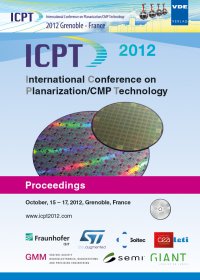Relationship between Spatial Wavelength Pad Surface Profile and Pattern Step-height Reduction with 28 nm Ceria Particle Slurry
Conference: ICPT 2012 - International Conference on Planarization / CMP Technology
10/15/2012 - 10/17/2012 at Grenoble, France
Proceedings: ICPT 2012
Pages: 6Language: englishTyp: PDF
Personal VDE Members are entitled to a 10% discount on this title
Authors:
Moon, Jinok (Samsung Electronics, San#16 Banwol-Dong, Hwasung-City, Gyeonggi-Do 445-701, Korea )
Bae, Jae-Young; Seo, Jihoon; Paik, Ungyu (Hanyang University, 17 Haengdang-Dong, Seoungdong-Gu, Seoul 133-791, Korea)
Abstract:
SiO2 material removal rate with different size ceria particle slurries were measured. Pad hardness, roughness, pad surface-wafer contact area were observed. Spatial wavelength pad roughness analysis was conducted to quantify pad surface-wafer contact property. Three types of noble diamond disks were employed to generate different pad surface roughness. Harder pad increases blanket oxide film removal rate with larger ceria particle slurries, but no significant difference among pads with 28 nm wet colloidal ceria particle slurry. As pad hardness decreases, longer spatial wavelength surface roughness increases. The spatial wavelength pad roughness property, especially in longer wavelength region, has strong relationship with initial step height reduction speed. Semi-blocky type diamond disk creates longer wavelength pad roughness profile compared to the other disk types. Keywords: pad hardness, spatial wavelength, step height, diamond disk


